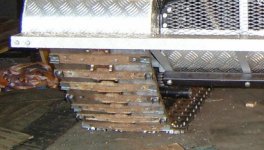Question, Are the big wheel 3 band ST4's more or less likely to slip a track than the earlier two band 6 boggie setup? I have learned the big wheel 3 band model was devolped to help prevent this. But I have also heard that while it does so in most conditions, there is a type of condition that favors the 2 band set up....
I guesss I am a little confused about this. It seems there are more of the earlier set up for sale than the later 3 band. I really would like to purchase a machine some time soon, and am beginning to think that it is one of the key differences between the later and the earlier machines. So what is your opinion anyway, and if you have been around each type? After detracking a Ski Dozer earlier this winter and having to "extract" it from the trail, I am a bit sensitive as to this issue......
I really want to of course not only get a decent buy on an ST4, but also a machine that will not give me too much trouble in operation, at least not initially. I am old enough and busy enough not to want to have to start with a worn out one that has a good paint job on it ....And I am willing to pay very well for a very good one.
....And I am willing to pay very well for a very good one. I am however a bit intimidated, as I have never even seen one in other than pictures before!
I am however a bit intimidated, as I have never even seen one in other than pictures before!
Any pointers on what a potential Snow Trac buyer should look for in a prospective machine would be appreciated. Maybe some day when I am more confident as to what I should choose, I will post in the WTS/WTB section. But for now I still have some things to learn, and my money is in my pocket waiting for the right one to show up. I really don't want to mess up, and purchase someone else's headache. I already have enough of my own!!!
I already have enough of my own!!!
By the way I know I want the 54 HP engine or more.....Out here where it is flat, I can go fast, as there is not really much to see.....
So what say you...... 2 band small wheel or 3 band "big" wheel?
Best regards, Kirk
I guesss I am a little confused about this. It seems there are more of the earlier set up for sale than the later 3 band. I really would like to purchase a machine some time soon, and am beginning to think that it is one of the key differences between the later and the earlier machines. So what is your opinion anyway, and if you have been around each type? After detracking a Ski Dozer earlier this winter and having to "extract" it from the trail, I am a bit sensitive as to this issue......

I really want to of course not only get a decent buy on an ST4, but also a machine that will not give me too much trouble in operation, at least not initially. I am old enough and busy enough not to want to have to start with a worn out one that has a good paint job on it
 ....And I am willing to pay very well for a very good one.
....And I am willing to pay very well for a very good one. I am however a bit intimidated, as I have never even seen one in other than pictures before!
I am however a bit intimidated, as I have never even seen one in other than pictures before! Any pointers on what a potential Snow Trac buyer should look for in a prospective machine would be appreciated. Maybe some day when I am more confident as to what I should choose, I will post in the WTS/WTB section. But for now I still have some things to learn, and my money is in my pocket waiting for the right one to show up. I really don't want to mess up, and purchase someone else's headache.
 I already have enough of my own!!!
I already have enough of my own!!!By the way I know I want the 54 HP engine or more.....Out here where it is flat, I can go fast, as there is not really much to see.....
So what say you...... 2 band small wheel or 3 band "big" wheel?

Best regards, Kirk


